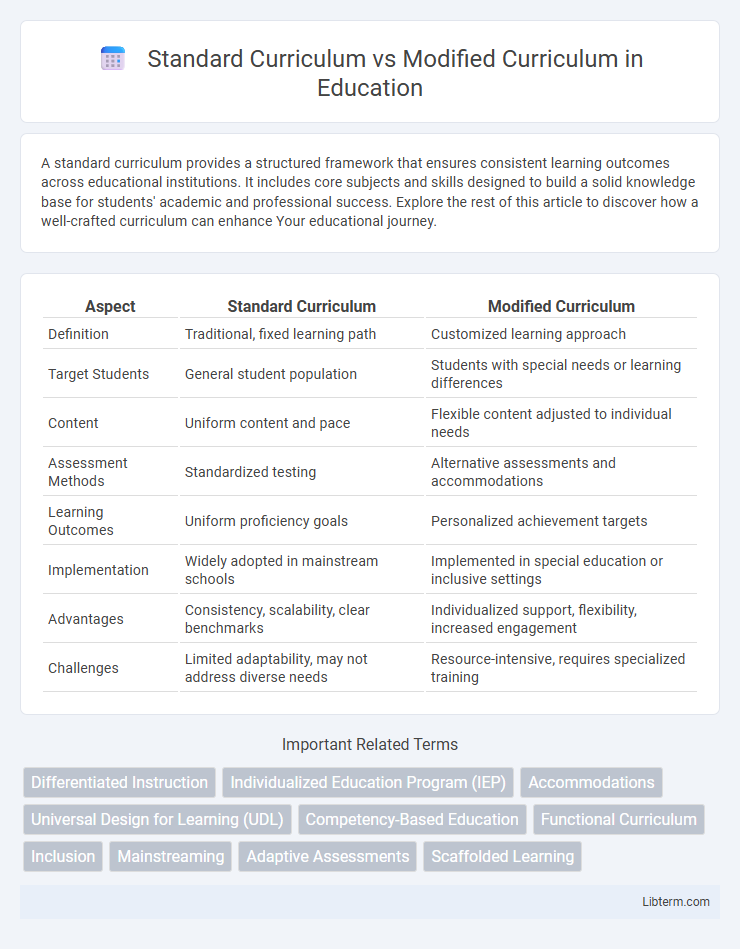A standard curriculum provides a structured framework that ensures consistent learning outcomes across educational institutions. It includes core subjects and skills designed to build a solid knowledge base for students' academic and professional success. Explore the rest of this article to discover how a well-crafted curriculum can enhance Your educational journey.
Table of Comparison
| Aspect | Standard Curriculum | Modified Curriculum |
|---|---|---|
| Definition | Traditional, fixed learning path | Customized learning approach |
| Target Students | General student population | Students with special needs or learning differences |
| Content | Uniform content and pace | Flexible content adjusted to individual needs |
| Assessment Methods | Standardized testing | Alternative assessments and accommodations |
| Learning Outcomes | Uniform proficiency goals | Personalized achievement targets |
| Implementation | Widely adopted in mainstream schools | Implemented in special education or inclusive settings |
| Advantages | Consistency, scalability, clear benchmarks | Individualized support, flexibility, increased engagement |
| Challenges | Limited adaptability, may not address diverse needs | Resource-intensive, requires specialized training |
Understanding Standard Curriculum
The Standard Curriculum follows a structured framework aligned with national education standards, ensuring comprehensive coverage of core subjects such as math, science, language arts, and social studies. It emphasizes skill development, critical thinking, and knowledge acquisition at grade-appropriate levels, facilitating consistent assessment benchmarks. This curriculum supports uniform educational goals designed to prepare students for standardized testing and higher academic pursuits.
Defining Modified Curriculum
Modified curriculum involves adapting educational content and instructional methods to meet the individual needs of students who require alternative learning approaches due to disabilities or learning challenges. This approach adjusts the complexity, pace, or goals of the standard curriculum to ensure accessibility and meaningful progress toward academic standards. Unlike the standard curriculum, which follows uniform grade-level expectations, the modified curriculum personalizes objectives to support diverse learning abilities and promote academic success.
Core Differences Between Standard and Modified Curricula
Standard curriculum follows a predetermined sequence of grade-level content designed to meet state or national education standards, emphasizing uniform learning objectives and assessments. Modified curriculum adapts the content, pace, and complexity to accommodate students with diverse learning needs, often incorporating individualized goals and alternative assessment methods. These core differences impact instructional strategies, student engagement, and learning outcomes by aligning educational delivery with each student's unique abilities and requirements.
Benefits of Standard Curriculum
The Standard Curriculum offers comprehensive coverage of core academic subjects designed to meet national education standards, ensuring consistent knowledge acquisition across diverse student populations. It promotes critical thinking, foundational skills, and college readiness by adhering to structured learning objectives and well-researched teaching methodologies. Students following the Standard Curriculum benefit from familiar assessment benchmarks, which facilitate tracking academic progress and maintaining competitive academic performance.
Advantages of Modified Curriculum
Modified curriculum offers tailored instruction that meets diverse learner needs, improving engagement and academic success for students with different abilities. It emphasizes flexibility in pacing, content, and assessment methods to accommodate individual learning styles and goals. This approach fosters greater inclusivity and supports skill development by addressing specific challenges and strengths.
Challenges with Standard Curriculum
Standard curriculum presents challenges such as lack of flexibility to accommodate diverse learning styles and paces, leading to disengagement among students with special needs or different cognitive abilities. Its rigid structure often struggles to address individual differences, resulting in limited differentiation and inadequate support for students requiring personalized instruction. In contrast, a modified curriculum offers adaptations that better meet varied educational requirements, enhancing student engagement and learning outcomes.
Limitations of Modified Curriculum
Modified curriculum often limits students by reducing academic rigor and content complexity compared to the standard curriculum, which may hinder skill development and knowledge retention. These limitations can result in fewer opportunities for higher education or competitive career paths due to gaps in essential competencies. Challenges in alignment with grade-level standards also affect consistency in educational outcomes and assessment measures.
Suitability for Diverse Learners
The standard curriculum provides a consistent framework designed to meet general educational standards, benefiting learners who thrive in structured environments. Modified curriculum adapts content, pacing, and assessment methods to accommodate students with diverse learning needs, including those with disabilities or language barriers. Tailoring instruction through modifications enhances accessibility and promotes equitable learning outcomes across varied cognitive and developmental profiles.
Implementing Curriculum Changes in Schools
Implementing curriculum changes in schools requires careful consideration of the differences between standard curriculum and modified curriculum, ensuring alignment with student needs and educational goals. Standard curriculum follows prescribed learning objectives and assessment criteria, while modified curriculum adapts content and instructional strategies for students with diverse learning abilities or special needs. Effective implementation involves teacher training, resource allocation, and continuous evaluation to balance curriculum rigor with accessibility and inclusivity.
Impact on Student Outcomes and Success
Standard curriculum provides a consistent framework designed to meet grade-level expectations, promoting uniformity in academic achievement and preparing students for standardized assessments. Modified curriculum adapts content, pace, or complexity to accommodate diverse learning needs, often resulting in improved engagement and individualized mastery but may affect comparability of outcomes across peer groups. Research indicates tailored modifications support students with learning disabilities by enhancing confidence and skill acquisition, ultimately influencing long-term educational success and self-efficacy.
Standard Curriculum Infographic

 libterm.com
libterm.com